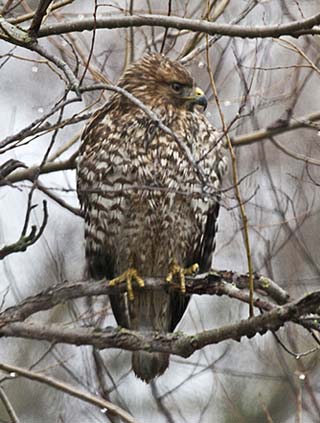
Copyright © Noella Ballenger
Very wet Red Shouldered Hawk – This was a really wet hawk early one morning. In the Colusa Preserve, early one morning, this hawk was just sitting about 12 feet from the road in a tree looking about as cold as we felt. <style=”font-size: 10.0pt; font-family: Georgia”>
In my article from last October, we visited the various Wildlife Preserves around Northern California. Each winter I travel to this area with a group of friends to photograph the migrating birds that swoop in from the North to take refuge for the winter. It’s always a fun time and in the past we have been very fortunate to have clear, crisp days and lots of ducks, snow geese and other water fowl beckoning us to click those shutter buttons. They congregate in not only the large wildlife refuges, but in the adjacent farmer’s fields where many acres of rice are grown. Those farmers wisely and kindly leave some areas and small parts of fields uncut so that there is plenty of food available for the birds and the other animals that need sustenance during the winter.
This years trek proved to be different from our previous trips–it didn’t quite go according to our plans. The ducks and geese didn’t seem as plentiful as in the past. There could be a couple of reasons for this occurrence. It was colder than previous years, so they may have flown further south. And, we were driving our way through Tule Fog—the thick ground fogs that appear during the winter months in the Central Valley of California. Tule Fogs are named after the wetlands Tule Grasses (tulares) of the Central Valley and they can make driving a challenge … to say nothing of trying to capture the photos you had visualized in your minds-eye.
But we were here! This was the time we had chosen, so we moved forward, setting out to visit the landscape that awaited us. We drove through the beautiful wildlife refuges and surrounding lands looking for birds, other animals and interesting glimpses of scenery cloaked in fog.
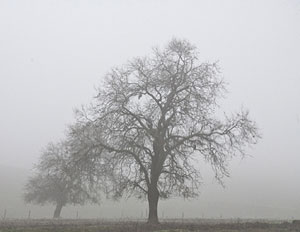
Copyright © Noella Ballenger
Tule Fog – Tule fog is an especially dense fog layer that is formed after heavy rains, during calm winds and during periods of rapid cooling during the night. The California central basin is a location where “trapped” air has no place to flow and break up, so it becomes very thick—up to an altitude of around 1,000 feet. It can last for days or weeks undisturbed.
While every nature photographer wants weather and light conditions to be superb so that the opportunity of bringing home great photographs is optimized, that isn’t the way it happens much of the time. With heavy fog like we encountered there were some real technical challenges. Fog acts like a super light diffuser or softbox in cutting contrast. While this may look great for landscapes, it becomes a problem when you are photographing a dark bird against white sky. And yet, with the fog so thick and white, many of the images became silhouettes and with unacceptable contrast. And yet, the camera’s light meters are frequently fooled into thinking they need to decrease the exposure for the diminished amount of light when they may need to open up (similar to shooting in snow where the snow becomes almost a reflector). So it became a balancing act of not enough light to too much contrast. The one thing you don’t want to do is use a flash in these conditions because it is similar to using your automobile’s high beams in fog.
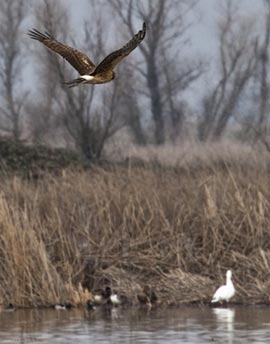
Copyright © Noella Ballenger
Northern Harrier – Harriers can be recognized by their distinctive flight pattern and the very distinctive white mark at the base of their tail. The preserves are quite large and in the distance I saw this Northern Harrier. They tend to cruise low and capture their prey in an abrupt twisting pounce from just a few feet above.
Stopping the action of flying birds meant that your speed had to be really fast, but that fast speed in these conditions meant moving the ISO to ranges that would give an image with a great deal of noise. And getting things sharp was a major problem as well.
And as the light changed with the ebb and flow of the fog, so did the shooting conditions. Shooting raw and post processing is one option … but I really like to get the best image in the field. So what do you do … well you just do your best. You shoot and then change something, try again and if that doesn’t work, you try changing something else. This is why it becomes critically important to know your camera and to check the in-camera results more frequently. I can tell you that photography becomes very frustrating under these extreme conditions.
So often photographers go with a specific mind set about what they want to photograph and then close themselves off from great opportunities. It is easy to do and the results can be so disappointing if you set yourself up for that. You need to have goals, and you need to reach for those special images, but then you also have to keep your mind open to other opportunities and other possibilities. And you need to try to do your best at both of these.
Well, this was the situation that Mother Nature presented to us and how we tried to make the best of it. In the past we had concentrated on large flocks of geese and a variety of ducks. This time we kept seeing raptors and hawks. Most of the time they were sitting with wet feathers and not looking particularly pleased with the weather either. But we saw them fly and worked on getting them as they took off or landed and we worked on panning along with the camera as the bird flew–a lot more difficult than you can imagine. There were also a number of heron and egrets. We looked for other critters carefully when we didn’t find birds and began to see more than we expected. Because our mind wasn’t set to watching these other critters on previous trips, this time we took what we were lucky enough to find and discovered all sorts of interesting behaviors.

Copyright © Noella Ballenger
Tule Elk – Elk are a part of the deer family and, as such, are hoofed animals and chew their cud. The males have antlers that they shed every year. Tule Elk are a dwarf elk and are found only in special locations in California. They were once considered extinct until a small herd was found in Kern County, California. Since their discovery, the herd has been divided into several herds and relocated to areas on both the eastern and western sides of the Sierra Nevada Mountains. They have made a major comeback in their numbers.
Were all of the photographs good? Well, as I explained to one of my on-line classes the other day, it is said that the principle difference between a professional photographer and an amateur photographer is the size of their wastebasket! It got really filled up this week, but there were a few images that were special and maybe it was because we had to work so hard to get them.
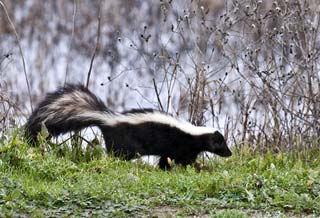
Copyright © Noella Ballenger
Striped Skunk – We were delighted to see this nocturnal hunter, the striped skunk. He feeds on mice, eggs, insects, grubs, berries and carrion. Because they prefer semi-open, prairie type areas with water nearby, the wildlife preserves of the Central Valley are an ideal habitat. While we were photographing this skunk, he or she was a “perfect gentleman or lady” and did not spray us leaving their very distinct odor wafting through the area.
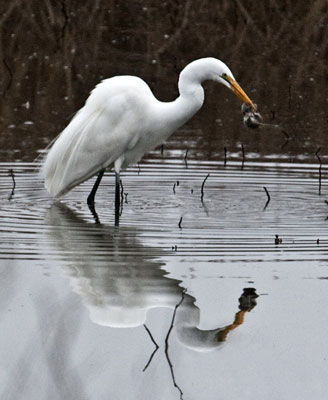
Copyright © Noella Ballenger
Great Egret – Great Egrets like to forage in shallow water or grassy mashes. They move slowly and carefully with their long neck extended. While I knew that they liked fish and other aquatic prey, I was surprised to see this egret capture a field mouse and dunk it several times before eating it.
And were we prepared for this “turn of events”? Yes! As photographers, if you remain too rigid in your thought process, you may not take along what is needed to enjoy a new adventure that may be presented to you. So while you’re packing, try to think, what if…..
LIST OF EQUIPMENT AND WEATHER GEAR
Whenever I go out on this kind of trip it is important to be prepared. Since I believe in “creature comfort” … mostly mine … here is a short list of some of my personal gear. All of my clothing is plenty warm but allows me a great deal of flexibility, because I am using the car as a blind and need to be able to twist and turn as you shoot out of the windows. It is amazing how we sometimes forget some of these basic essentials.
Personal Gear:
-
Warm but lightweight jacket and vest (I like layers)
-
Long underwear and thermal turtlenecks (more layers)
-
Gloves, hat and lap robe–it can get very cold when you are driving slowly or sitting with all the windows open.
-
Rain pants or wind pants and rain jacket
Camera Gear:
-
Usually 3 cameras (Canon 5D, 30D’s) in case something breaks.
-
Lots of batteries (I carry 8 batteries and charge them each night)
-
Lots of media cards (I carry eight cards – either 4 or 8 mb and will be adding more next time.)
-
Lenses: 100-300, 100-400, 28-300 and 1.5 teleconverter
-
Tripod
-
Window pod or beanbag and section of pipe insulation–this protects the edge of the window and gives the camera support while you are shooting or between shots.
-
Plastic bags – protection for the camera in case it rains.
-
Soft towel and lens cloth to wipe down gear in case it gets wet
Computer Gear:
-
Laptop computer
-
Portable hard drives (3-4 hard drives – 300 gb each)
-
All of the cords and wires needed (I double check this because it is so critical)
HERE’S WHAT I DO EACH EVENING AFTER GETTING IN FROM THE FIELD:
-
Begin charging all batteries (even if I haven’t used it, it is checked)
-
Start downloading each of the media cards
-
Wipe down and clean gear for the next day
-
Review images (I personally don’t like to edit when I am on a trip except for the focus and exposure disasters)
-
Overnight – copy images from computer to another hard drive so that I have 2 copies of each day’s shoot.
-
Before going out for the day, I format all media cards in the camera
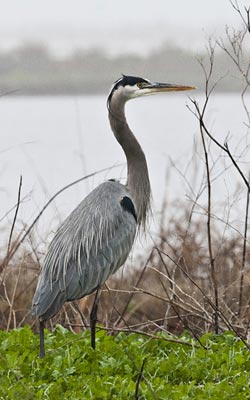
Copyright © Noella Ballenger
Great Blue Heron – The Great Blue Heron is a magnificent bird. It is very large … about 46 inches in height and has a wingspread of around 6 feet. It feeds primarily on fish and small mammals. As a photographer waiting for “the action”, the heron and egret are role models for learning patience. They can stand perfectly still for the longest time, while waiting for their prey to make a move.
Now, if some of your winter photo shooting days seem to appear dreary and not as you had hoped, that’s O.K., let’s all promise to get out there, grab the opportunity to capture some new great photos and just do our best.
by Noella Ballenger

Leave a Reply